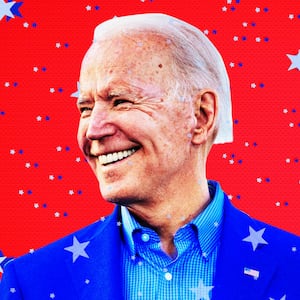For those who want the Biden Experience, being there in person is just a given.
The ability to look you in the eye, give you a hug, or, if warranted, a pat on the back, has guided the former vice president’s personal political style for decades. His physical presence is foundational to it.
So when his campaign announced that he would speak in a “virtual” capacity about “restoring the soul of the nation” and “unifying the country,” among other more specific things, with community leaders in Chicago on Friday night, it wasn’t clear exactly how well that would go over. Thirty minutes after the event was supposed to take place on Facebook Live, only 475 people indicated they were “interested” in it, using the tech company’s tool to express that. By the time it went live, there were nearly 5,000 viewers, but the format was rife with technical problems blurring the whole experience.
ADVERTISEMENT
“Am I on camera?” Biden, wearing a blue and white pinstripe shirt, asked at the very start of the video conference. “I’m sorry this has been such a disjointed effort here because of the connections,” he said at the end of it, only a few minutes later.
Immediately following the event, it still wasn't clear how it was received, aside from a lively comment section. But that’s obviously because, for the first time since addressing the nation in person about the growing threat of the coronavirus pandemic, the former vice president, and the rest of America, was advised to avoid large gatherings of people.
While Biden didn’t start out attracting the largest crowds among Democratic presidential contenders, the growing interest in his status as the primary’s frontrunner has injected new life into his bid. Those who know him best say he’s likely to excel in an all-digital format.
“The virus may be prompting unprecedented changes to campaigns and campaigning, but the charisma and empathy that make Vice President Biden who he is... don’t just happen in person and will certainly endure online and on air,” Scott Mulhauser, Biden’s former deputy chief of staff during the 2012 election, told The Daily Beast. “He is just not going to stop engaging voters to try to win over every last one of them,” Mulhauser added, “even if that means doing so remotely to meet them where they are.”
But it didn’t translate into that on Friday night. Joining in isolation from a small apartment living room in Washington, D.C., The Daily Beast was just one of many media outlets endeavoring to cover a presidential cycle once abundant with in-person events—from large-scale rallies to intimate house parties and door-to-door canvassing—from a socially distant, i.e. away-from-other-people, point of view.
“We do apologize for the technical difficulties we had,” the event’s moderator said.
As the virus continues to spread throughout the country, with 48 states now affected, the 2020 campaign landscape is likely to morph into a more remote experience with fewer in-person interactions.
“It shifts the format for the conversation. You’re going to be talking on the phone, engaging in peer-to-peer messaging,” said Matt Compton, who oversees engagement and advocacy at the Democratic digital firm Blue State. Compton has seen the inner workings of campaigns’ digital operations closer than most—having previously served as deputy digital director of Hillary for America in 2016, he also ran the digital program for the Democratic National Committee and worked on digital content strategy at the White House under the Obama administration.
“Good campaigns have already been thinking about this,” Compton said. “If people are stuck in a routine of less novelty—if they are at home every day, eating the same breakfast every morning—then a campaign that is doing something creative can be a real way to make a connection where they might not have been able to,” he added. “Campaigns should be asking themselves how to take advantage of that opportunity.”
For Biden, some experts and campaign veterans say this means using every tool available to keep momentum and primary engagement alive with many months to go before the general election.
“We’re going to hit a point where Biden winning is no longer an interesting story,” said Dave Goldstein, an Obama campaign alum who is now the CEO of Tovo Labs, a progressive digital consulting firm. “All of that earned media is going to go away, and all that’s going to remain is a digital operation that’s been sadly lacking for months.”
On the tactical front, Biden’s campaign has “significantly increased” their spending on Facebook and Google since Super Tuesday, according to Bully Pulpit data shared with The Daily Beast. Biden’s campaign spent roughly $3.9 million in advertising on Facebook and Google during the first week of March, compared to just roughly $327,000 during the first week of February.
In addition, the campaign has restructured parts of its senior staff. On Thursday, officials announced the hiring of Jennifer O’Malley Dillon, who served as deputy campaign manager for Obama’s reelection campaign and most recently worked for former Rep. Beto O’Rourke (D-TX), as its new campaign manager. She also previously managed data, analytics, and technology infrastructure at the Democratic National Committee.
“We have to make the adjustment into the modern era of campaigning very quickly,” Shola Farber, another Clinton campaign alum who co-founded the Tuesday Company, a firm that aims to reimage political engagement for the digital age. “Everything you do in person can be done digitally if you are using the right tools,” she added.
Addressing viewers on Friday, Biden, holding a black iPhone up in front of his mouth to address questions, spoke briefly about the differences between his health care approach and Sanders,’ a theme that’s echoed throughout the 2020 election. But much of the brief event’s substance was dimmed by technical glitches and delays.
Some Democrats and security experts recently expressed concerns that Biden’s campaign—both in its current digital capacity and rapid-response strategy—was not sufficient to match the robust online infrasture of Trump’s re-election campaign. Well past the hour that Biden was supposed to appear on screen, a badge next to a circular image of his face read simply, “Joe Biden plans to go live.”
Just after the event wrapped up, Biden’s campaign fired off an email that seemed to acknowledge the event’s problems.
“Thank you for your patience as we continue developing our virtual town halls and ensure voters have the opportunity to connect with Vice President Biden as he lays out his vision for America,” it read.






